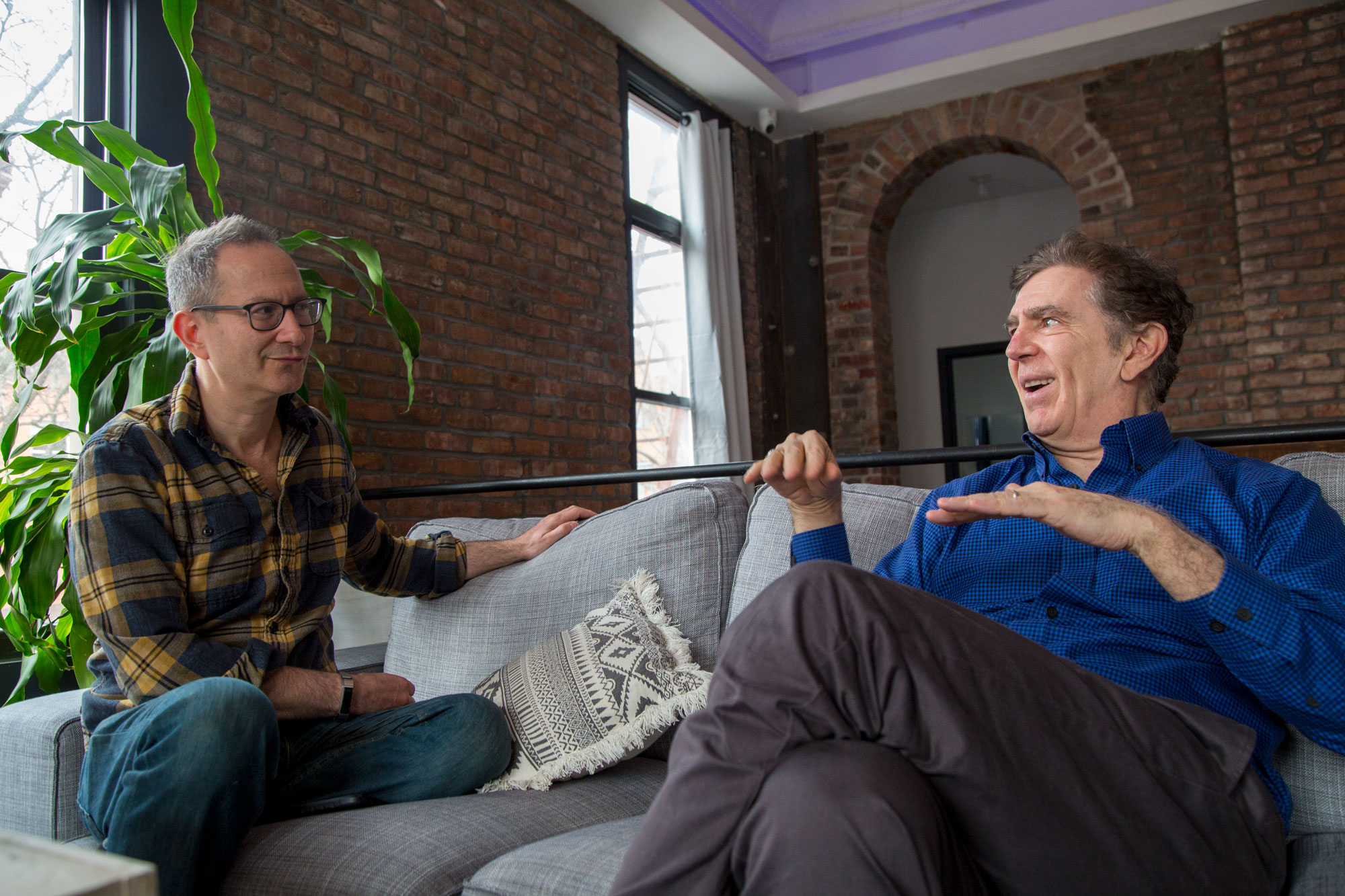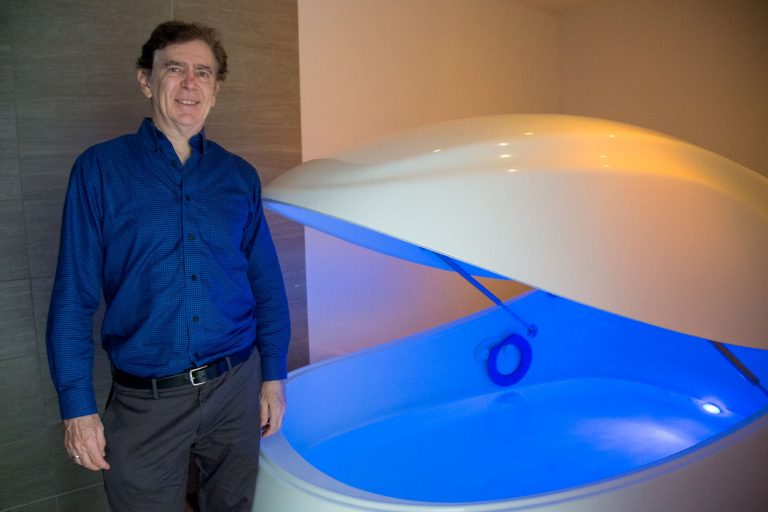The use of sensory deprivation tanks, or flotation tanks, has grown more popular in recent years. The tanks are filled with a concentrated solution of Epsom salt and water, which is heated to skin temperature, and then sealed inside a sound- and light-proof room. The result is that people can float in what feels like a void. While flotation proponents list a variety of benefits, many seek out sensory deprivation for a meditative experience or to enhance an already existing meditation practice. The idea is that by removing sensory distractions, a floater is free to fully confront their mind—an idea shared by Tibetan Buddhist dark retreats.
So can flotation tanks offer a boost to Buddhist meditation practices? To find out, Tricycle conducted an unscientific experiment: we invited meditation teacher Loch Kelly to test his contemplative practice in a floatation tank for the first time. Kelly is a licensed psychotherapist who has studied meditation for decades under such teachers as Tulku Urgyen Rinpoche and Mingyur Rinpoche. He also founded the Open-Hearted Awareness Institute in New York, where he teaches contemplative practices.
Kelly arrived at Lift Floats in Brooklyn, where the owner, David Leventhal, walked him through using the tanks. Before entering the pod-like device, Kelly shared his expectations: “I plan on treating it like a meditation room. I’ll try to let go almost like I’m sitting on a cushion, but I’ll be lying on my back. And I’ll be open to what’s new.”
A little over an hour later, Kelly emerged and sat down with Tricycle to discuss his experience.
So I’ll start with the most general question. What did you think?
It was great. Very relaxing. The main thing I felt was just deep relaxation.
In the beginning, I spent time getting adjusted. It was like trying to float in the ocean or a bay. Then, as I relaxed into it, I felt more like I was in lying a hammock—because your feet are up, but the butt is down. Then it started to feel like I was a kid being held by my parents. That definitely is some kind of positive support. Then it started to feel like a memory foam mattress. But as soon as I moved a little bit, it felt like being in very firm jello.
Most beginning meditators in the West deal with pain in their knees and body because they have to sit with their knees on the ground and straighten their spine. But in the tank, there’s none of that. So for beginners, if you’re dealing with pain that keeps you from relaxing; this takes all of that out.
For people who tend to fall asleep while meditating, the tank might be not be as good, because you are in a supine position. There were definitely times I got right to the edge of almost falling asleep. But then I caught myself and became aware that my brain and my body had entered another level of letting go, which actually felt good.
After that, I started experiencing creative thinking. I thought, “Oh, I see. That’s how I should organize the book I’m writing. Oh, well that’s simple. Why not do it that way?”
You’re writing a book right now and had a breakthrough?
Yes, I’m writing about a practice I call “effortless mindfulness.” I wrote the book as a big overview that connects contemporary thought and a variety of traditions and psychology. But now I’m going to go back and make it simpler and just do a practice book. I was able to see how to organize it, how to make it simple.
What are some of the practices that you’ve tried out in the tank?
I went through a series of practices, and in between each practice I had a period of doing nothing—just watching the breath. I found that the shamatha [calm abiding] practice was very easy and comfortable. I didn’t get caught up in any thought for more than a few seconds. It was easy to see what was arising and feel everything and welcome it.
Immediately after observing the breath, I do a practice I call “awareness of awareness.” Rather than just being a mindful witness, my awareness actually discovers it is already aware of itself. I’m not doing it. And that awareness is able to be aware inside and out of my body continuously. There’s a seamless, interconnected field of experience that creates a bliss in the body.
Then I did some lovingkindness, which was very sweet. Some of the good feeling of being held and supported was definitely emphasized in this float.
And then I did a little of what’s called togal practice, which is similar to the awareness of awareness practice. Togal is starting to realize that awareness is not just pure awareness. It’s almost like you’re the sky and everything is just going through, and then actually the things are made of the sky, too. I was looking at the little movements of light that are on the back of the eye, and then everything felt like this dynamic intelligence that’s energetic and flowing. So in the dark, that was easier to do.

Was it a little bit more effortless than it would normally be?
It was definitely supportive. It was like a retreat center in a box. At a retreat, you go to a supportive environment that’s out of the way, and here you’re going in the middle of the city to something that’s almost like a micro-retreat.
Do you think this is something that you would want to incorporate into your regular practice?
I might, if it was available and easy. I’ve been practicing for a while, so I can go to that peaceful place in the subway. So it would have to be very convenient.
Was there anything you didn’t like about it—such as the lack of ritual?
I don’t have much ritual in my practice. I’m very contemporary.
The story of the Buddha under the Bodhi tree says that he meditated on a pile of grass, but now we use cushions that are filled with various materials.
That whole sitting posture, which Zen in particular takes very seriously, doesn’t actually matter as long as you aren’t fighting your body. Sitting on your knees was from before people had chairs: chairs were the first technology.
People always say posture is the most important thing, and then breath is the next most important thing, and then attention, attention, attention. Actually, none of those three are really necessary. It could be helpful in the beginning, but it’s really about awareness, which is not attention. Certainly relaxation is important, which this helps with.
Some people view floatation as similar to a psychedelic experience, providing a glimpse into our consciousness’s ability to shift.
There’s a famous quote by [the spiritual teacher] Ram Dass that basically says that psychedelics are a good window, but not a good door. They offer an extreme example that there’s relative reality or alternative perception. But you don’t want to live in that state. You want to be in more of a flow state—optimally functioning—where things aren’t as tight, but they’re not as loose either. Meditation, especially the more advanced meditation styles, seek this flow rather than just calm.
Do you think sensory deprivation is a possible window to that flow state?
I think this is a technology that can help get you more supportively into or out of the little anxious “mini-me,” which is still running when you sit. It takes a longer amount of time to get into a rhythm during seated meditation. This is quicker. It’s a more contemporary, effective way.
Thank you for subscribing to Tricycle! As a nonprofit, we depend on readers like you to keep Buddhist teachings and practices widely available.
